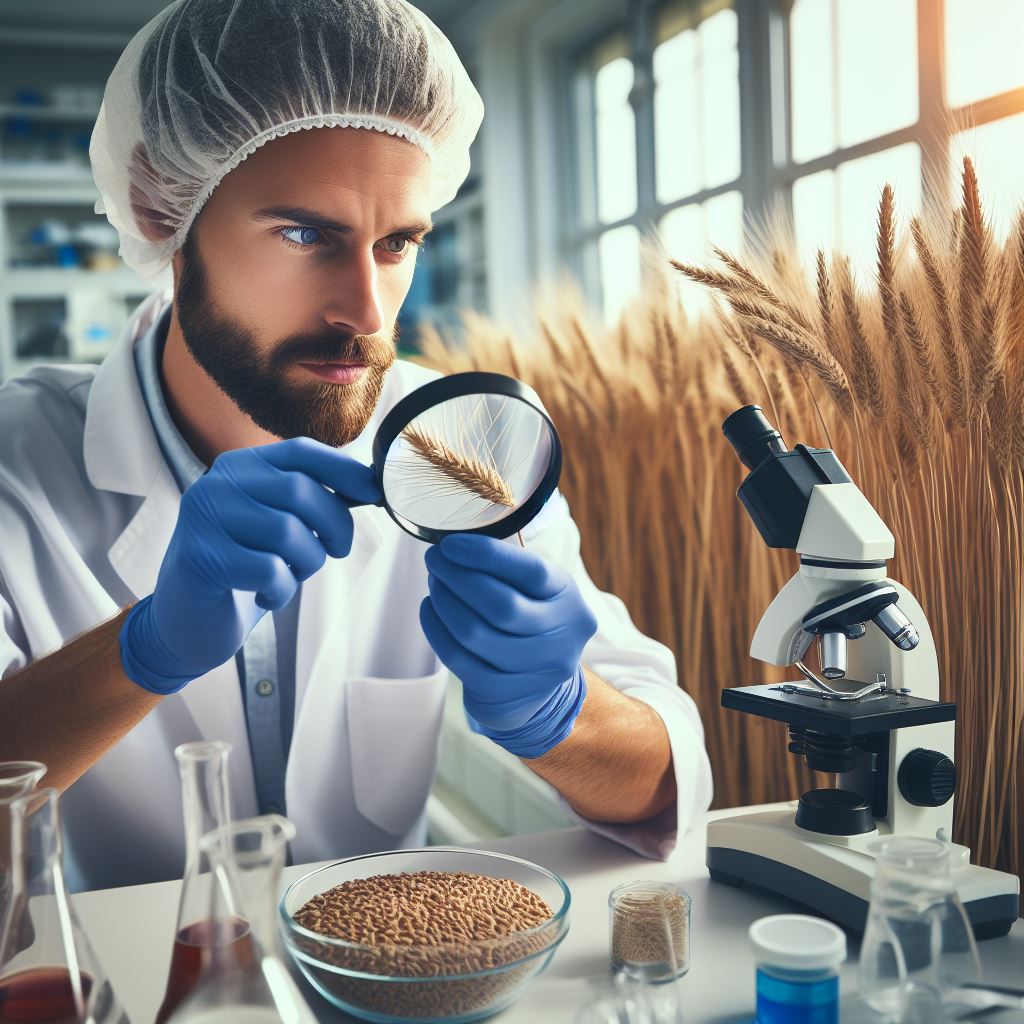Introduction
Climate change disrupts agriculture globally, posing significant threats to food security, including climate change impact on crop yields.
This blog post focuses on the direct consequences of climate change on crop yields.
Climate change, driven by human activities, alters weather patterns, leading to extreme events.
These extremes include droughts, floods, heatwaves, and unpredictable shifts in temperature and precipitation.
Such disruptions challenge the delicate balance required for optimal crop growth and development.
Farmers face increased uncertainty, struggling to adapt to rapidly changing conditions.
Crop yields suffer as crops experience stress from adverse weather conditions.
Extreme heat can reduce photosynthesis rates, stunting plant growth and reducing yields.
Erratic rainfall patterns disrupt planting schedules and hinder proper crop development.
Pests and diseases thrive in warmer climates, further threatening crop health and productivity.
These challenges exacerbate existing inequalities, disproportionately affecting vulnerable communities and regions.
Addressing climate change’s impact on crop yields requires urgent action and innovative solutions.
Stay tuned to explore strategies for mitigating these effects and building resilience in agriculture.
Definition and Causes of Climate Change
Climate change is a pressing issue that has garnered significant attention in recent years.
It refers to long-term shifts in weather patterns and temperatures, which have wide-ranging implications for various aspects of life, including agriculture and crop yields.
In this blog section, we will explore the definition of climate change, discuss its causes, and highlight its importance in the context of crop production.
A. Concept of climate change and its implications
Firstly, the concept of climate change encompasses more than just short-term fluctuations in weather.
It refers to long-term shifts in weather patterns, including changes in temperature, precipitation, and wind patterns, among others.
These changes can occur on a global scale or be specific to a certain region.
Climate change affects not only average conditions but also the frequency and intensity of extreme weather events, such as droughts, floods, and heatwaves.
Such shifts in climate can have profound impacts on crop yields and food production.
Transform Your Agribusiness
Unlock your farm's potential with expert advice tailored to your needs. Get actionable steps that drive real results.
Get StartedB. The primary greenhouse gases causing climate change
Climate change is mainly driven by the release of greenhouse gases into the atmosphere.
Greenhouse gases trap heat from the sun, preventing it from radiating back into space and thus causing the Earth’s temperature to rise.
The primary greenhouse gases responsible for climate change include carbon dioxide (CO2), methane (CH4), and nitrous oxide (N2O).
These gases are released through both natural processes and human activities.
C. Main contributors to increased greenhouse gas emissions
Human activities are the main contributors to increased greenhouse gas emissions.
Activities such as burning fossil fuels for energy, deforestation, and industrial processes release large amounts of CO2 into the atmosphere.
Additionally, agricultural practices, such as the use of synthetic fertilizers and the management of livestock, contribute to the release of methane and nitrous oxide.
These activities have significantly increased greenhouse gas concentrations in the atmosphere, leading to global warming and climate change.
D. Importance of understanding climate change for crop production
Understanding climate change and its implications is crucial for crop production.
Changes in temperature and rainfall patterns directly impact crop growth and development.
Different crops have specific temperature and moisture requirements, and even small shifts in these conditions can affect their productivity.
Extreme weather events, such as hurricanes or prolonged droughts, can destroy crops, leading to significant economic losses for farmers and impacting food security.
Moreover, climate change can also affect the distribution of pests and diseases, which can further impact crop yields.
As temperature patterns shift, pests and diseases may expand their range, potentially causing outbreaks in regions where they were previously absent.
This poses a significant challenge to crop production and requires adaptation strategies to mitigate these risks.
In fact, climate change is a complex phenomenon with far-reaching implications for crop production.
Understanding its causes and effects is essential for developing effective strategies to mitigate its impacts.
By reducing greenhouse gas emissions and implementing sustainable agricultural practices, it is possible to address climate change and ensure future food security in the face of a changing climate.
Read: Greenhouse Gases: Farming’s Role and Solutions
Climate Change and Crop Yields
A. The relationship between climate change and crop yields
Climate change and crop yields are closely linked, as changes in weather patterns directly impact agricultural productivity.
Rising temperatures and changing rainfall patterns adversely affect crop growth, leading to reduced yields and quality.
Extreme weather events such as droughts, heatwaves, and floods also pose significant challenges to farmers, exacerbating the negative effects of climate change on crop production.
Moreover, climate change disrupts the delicate balance of ecosystems, which further affects crop yields.
Changes in temperature and rainfall can lead to shifts in pest populations, increased prevalence of diseases, and altered nutrient availability in the soil, all of which negatively impact agricultural practices and reduce crop yields.
B. The direct and indirect impacts of climate change on crop production
The direct impacts of climate change on crop production are evident in the form of reduced yields and compromised quality.
Higher temperatures can shorten the growth period of crops, affect their photosynthesis process, and increase their water requirements.
Additionally, excessive heat can damage delicate reproductive structures, leading to wilted flowers and reduced pollination, which ultimately results in lower crop yields.
On the other hand, indirect impacts arise from climate change-induced changes in plant diseases, pests, and weeds.
Warmer temperatures and altered rainfall patterns can favor the proliferation of pests and diseases, thus increasing the risk of infestation and crop damage.
Changes in weed dynamics can also occur, with some weed species becoming more resilient and invasive, competing with crops for resources and reducing overall productivity.
C. Statistics and evidence to support the claim that climate change affects crop yields
There is a wealth of statistical evidence to demonstrate the negative impact of climate change on crop yields:
- According to a study published in Nature Climate Change, global maize yields have declined by 4% since the 1980s due to rising temperatures.
- The International Food Policy Research Institute estimates that a 2°C increase in temperature would reduce wheat, rice, and maize yields by 6%, 3.2%, and 7.4%, respectively.
- A report by the Intergovernmental Panel on Climate Change (IPCC) warns that climate change could decrease crop yields by up to 25% in the coming decades.
- Research conducted by the University of California, Davis, reveals that warmer temperatures caused by climate change have already decreased global rice and wheat yields by 10% and 5.5%, respectively.
These statistics highlight the urgency of addressing climate change and implementing sustainable agricultural practices to protect global food security and mitigate the adverse effects of climate change on crop yields.
Read: Climate’s Toll on Soil: Farming’s Unsung Hero
Changing Rainfall Patterns and Droughts
A. Impact of Changing Rainfall Patterns on Crop Yields
Changing rainfall patterns as a result of climate change play a significant role in determining crop yields.
Fluctuations in precipitation patterns can disrupt the growth and development of crops, affecting their overall productivity.
Excessive rainfall can lead to waterlogging, nutrient leaching, and increased risk of diseases, resulting in reduced yields.
Conversely, inadequate rainfall can cause moisture stress, hindering crop growth, and reducing yield potentials.
Thus, the impact of changing rainfall patterns can be both positive and negative, depending on the specific regional context.
B. Effect of Droughts on Agricultural Productivity
Droughts, which are becoming more frequent and severe due to climate change, pose a significant threat to agricultural productivity.
Lack of water availability during droughts limits plant growth, reduces crop production, and escalates the risk of yield failures.
Drought-induced water stress affects photosynthesis, nutrient uptake, and overall plant metabolism, leading to poor crop development.
Furthermore, droughts often result in soil degradation, decreased soil fertility, and increased susceptibility to pests and diseases.
These combined effects of droughts can have severe economic and food security consequences on farming communities.
C. Influence of Rainfall Variations and Droughts on Crop Yields
Several studies and examples illustrate the direct influence of rainfall variations and droughts on crop yields.
Showcase Your Farming Business
Publish your professional farming services profile on our blog for a one-time fee of $200 and reach a dedicated audience of farmers and agribusiness owners.
Publish Your ProfileResearch conducted in India showed that a 10% decline in rainfall reduced rice production by about 1.5–2%.
In the United States, the “Dust Bowl” droughts of the 1930s resulted in substantial crop failures and widespread agricultural devastation.
Similarly, a study in Australia revealed that droughts contributed to a significant decline in wheat, barley, and canola yields.
Moreover, regions experiencing prolonged dry spells have witnessed declines in overall agricultural output and livelihoods.
These examples and studies highlight the vulnerability of crop yields to rainfall variations and the adverse impacts of droughts.
Overall, changing rainfall patterns and droughts, influenced by climate change, pose considerable challenges to crop yields and agricultural productivity.
Understanding the impacts is crucial for developing effective strategies and adaptation measures to secure global food systems.
By prioritizing water management, implementing sustainable farming practices, and investing in technological advancements, we can mitigate these challenges.
Read: Innovative Crops: Beating Climate Heat & Drought

Increased Temperatures and Heat Stress
A. The impact of rising temperatures on crop yields can be significant and detrimental
- Higher temperatures can lead to reduced crop growth and lower overall yields.
- Heat stress can cause changes in photosynthesis, respiration, and other metabolic processes.
- Increased temperatures can also affect pollen viability and fruit set, resulting in poor reproductive success.
B. Heat stress affects different crops and their growth stages in various ways
- Crops like corn and wheat are particularly vulnerable to high temperatures during their flowering stage.
- Heat stress during the vegetative stage can lead to reduced canopy development and limited photosynthesis.
- Different crops have different temperature thresholds at which they start experiencing negative effects.
C. Examples and data demonstrate the correlation between increased temperatures, heat stress, and crop yield reduction
- Studies have shown that a temperature increase of just 1-2 degrees Celsius can reduce crop yields by 10-25%.
- In regions where temperatures have already risen significantly, crop yields have declined significantly as well.
- For example, the heatwave in Europe in 2003 resulted in a 30% reduction in wheat yields.
- Data from long-term studies indicate that heat stress events are becoming more frequent and severe.
- Increased temperatures and heat stress also exacerbate water stress, further impacting crop yields.
- The combination of high temperatures and drought can be particularly devastating for agriculture.
- Farmers in regions with high heat stress often have to resort to implementing adaptive strategies.
- These strategies may include selecting heat-tolerant crop varieties, altering planting dates, and implementing irrigation techniques.
- Despite these efforts, the overall result is often still a reduced crop yield compared to optimal conditions.
In short, the impact of increased temperatures and heat stress on crop yields cannot be underestimated.
This phenomenon affects different crops in different ways, but the overall trend is a reduction in productivity.
Examples and data clearly demonstrate the correlation between rising temperatures, heat stress, and decreased crop yields.
Farmers and researchers must continue to address this issue and develop innovative solutions to mitigate and adapt to the challenges presented by climate change.
Read: Future of Farming: Tech against Climate Change
Shifts in Pests and Diseases
A. Changes in pest and disease patterns due to climate change
Climate change has brought about shifts in pest and disease patterns, leading to significant consequences for agricultural systems.
As temperatures rise, pests and diseases are no longer confined to their traditional ranges.
Moreover, the changes in pest and disease patterns can lead to a decline in crop quality.
Pests and diseases can damage the crops, reducing their market value and making them unappealing to consumers.
This in turn affects farmers’ incomes and puts their livelihoods at risk.
B. How altered climatic conditions favor the spread of pests and diseases
The altered climatic conditions provide favorable environments for pests and diseases to thrive and spread.
Warmer temperatures and increased humidity create conditions that support the reproduction and growth of various pests and diseases.
Furthermore, the spread of pests and diseases can also disrupt crop pollination.
As certain pests and diseases affect pollinators like bees, it hampers successful pollination, resulting in reduced yields and lower crop productivity.
In addition, the increased presence of pests and diseases due to climate change necessitates the use of more pesticides and fungicides.
While these chemicals help control the spread of pests and diseases, they also have adverse effects on the environment and human health.
Furthermore, the alteration in pest and disease patterns can result in the loss of traditional crop varieties.
As pests and diseases adapt to the changing climate, they may target specific crop varieties, making it challenging for farmers to grow certain types of crops.
The shifts in pests and diseases also have widespread implications beyond crop yields.
They can disrupt entire ecosystems by affecting beneficial insects, birds, and animals that play vital roles in maintaining ecological balance.
C. Negative implications of these shifts on crop yields
The shifts in pests and diseases pose numerous negative implications for crop yields.
Firstly, they result in increased loss of crops due to infestations and infections.
Secondly, farmers are forced to invest more in pest control measures, which increases production costs.
To mitigate the negative impacts, farmers and researchers need to adapt their pest and disease management strategies to the changing patterns.
This may involve employing integrated pest management techniques and developing disease-resistant crop varieties that can withstand the challenges posed by climate change.
In essence, the shifts in pests and diseases due to climate change have significant implications for crop yields.
These changes lead to increased crop losses, decline in quality, reduced pollination, and greater reliance on pesticides.
Adapting and implementing sustainable pest and disease management strategies are crucial to safeguard agricultural productivity in the face of climate change.
Adaptation and Mitigation Strategies
A. Importance of adaptation and mitigation in addressing climate change impacts
- Adaptation and mitigation are crucial in addressing the impacts of climate change on crop yields.
- Adaptation helps farmers adjust and cope with the changing climatic conditions.
- Mitigation focuses on reducing greenhouse gas emissions to limit the severity of climate change.
- Both approaches are necessary to protect food security, farmers’ livelihoods, and the environment.
- Failure to adapt and mitigate can result in reduced crop yields, increased pests, and soil degradation.
- Effective adaptation and mitigation policies are essential for sustainable agricultural practices.
- Coordinated efforts from governments, farmers, and scientists are crucial to tackling climate change impacts.
B. Strategies and technologies that can help farmers adapt to changing climatic conditions
Farmers can adopt several strategies and technologies to adapt to changing climatic conditions:
- Use of drought and heat-tolerant crop varieties that are more resilient to extreme weather events.
- Implementing crop rotation and diversification to reduce the risk of yield losses.
- Improving water management techniques by utilizing efficient irrigation systems and rainwater harvesting.
- Employing precision agriculture methods to optimize resource use and minimize environmental impact.
- Investing in climate monitoring and early warning systems to anticipate changes and take timely action.
- Promoting agroforestry practices to enhance soil fertility, microclimate regulation, and carbon sequestration.
- Encouraging the use of organic farming practices to improve soil health and reduce greenhouse gas emissions.
C. Role of sustainable agricultural practices in mitigating climate change effects on crop yields
Sustainable agricultural practices play a crucial role in mitigating climate change effects on crop yields:
- Conservation tillage and minimum soil disturbance techniques help preserve soil structure and promote carbon storage.
- Proper nutrient management practices reduce nitrogen emissions and enhance fertilizer efficiency.
- Avoiding overuse of chemical pesticides and promoting natural pest control methods preserve biodiversity.
- Implementing agroecological approaches and organic farming reduces reliance on synthetic inputs and lowers emissions.
- Integrating livestock and crop production systems through innovative practices like agropastoralism reduces environmental impacts.
- Promoting sustainable land management practices helps prevent soil erosion and degradation.
- Supporting the use of renewable energy sources in agriculture reduces greenhouse gas emissions.
- Adopting these sustainable practices not only mitigates climate change but also improves soil fertility and farmers’ resilience.
- Furthermore, sustainable practices can enhance water efficiency, reduce waste, and protect ecosystems.
By implementing effective adaptation and mitigation strategies, farmers can better navigate the challenges posed by climate change and safeguard their livelihoods.
It is essential for policymakers, scientists, and stakeholders to collaborate and support farmers in adopting these strategies.
By prioritizing sustainable agricultural practices and utilizing innovative technologies, we can mitigate climate change effects on crop yields, ensure food security, and protect the environment for future generations.
Conclusion
A. Main points discussed in the blog post
We’ve detailed how climate change affects crop yields:
- Rising temperatures alter plant growth cycles.
- Extreme weather events damage crops unpredictably.
- Shifts in precipitation patterns disrupt farming.
- Pests and diseases proliferate in warmer climates.
B. Emphasizing the urgency to take action and address the adverse effects of climate change on crop yields
Urgent action is imperative to mitigate these impacts:
- Implement sustainable farming techniques.
- Invest in resilient crop varieties.
- Improve water management systems.
- Advocate for policies to reduce greenhouse gas emissions.
C. Encouraging readers to stay informed and support sustainable farming practices
Stay informed and support sustainable farming:
- Educate yourself on climate-smart agriculture.
- Engage with local farmers and agricultural communities.
- Promote policies that prioritize environmental sustainability.
- Choose sustainably sourced products to support ethical farming practices.
In closing, the time to act on climate change’s threat to crop yields is now.
By embracing sustainable practices and advocating for change, we can safeguard food security for future generations.
Stay informed, stay engaged, and support a resilient agricultural future.




